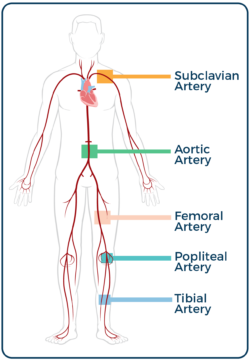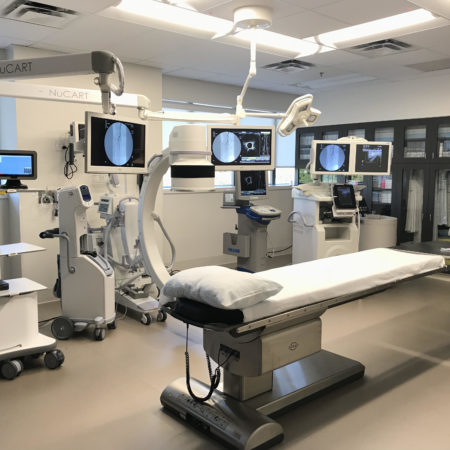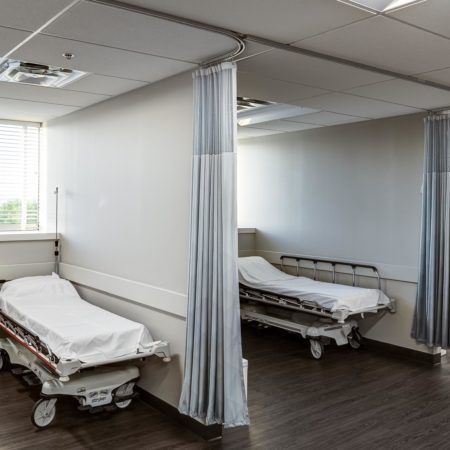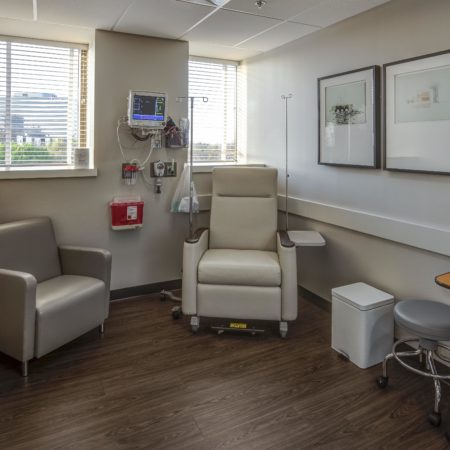Diagnostic Testing
The first step in treating vascular disease is first knowing it is there. That’s why at Lam Vascular & Associates, we offer state-of-the-art testing performed by experienced vascular specialists for the accurate diagnosis of a variety of conditions.
Ankle Brachial Index (ABI)
Likely the most important part of diagnosing Peripheral Artery Disease (PAD) and other vein and artery conditions is the ABI. Your ABI is determined by comparing the blood pressure in your arm to the blood pressure of your ankle.
If your ABI indicates that your blood pressure in your ankle is 10% lower than your general blood pressure, that is the first indicator of PAD. An ankle’s blood pressure that is 50% lower than your arm is considered a medical emergency and requires the immediate attention of an expert.
Doppler Testing
Another critical way of diagnosing vascular issues is doppler testing. This testing uses ultrasound to look for signs of decreased blood flow in the arteries or veins of a specific part of your body. This is an important test for determining exactly where blockages are in the vascular system and conditions such as deep vein thrombosis, vascular tumors and arteriosclerosis/atherosclerosis. Some of the common doppler tests we offer at Lam Vascular & Associates include:
- Lower extremity arterial doppler
- Upper extremity arterial doppler
- Upper extremity venous doppler
- Lower extremity venous doppler
- Carotid doppler
PAD Risk Factors

In-Office Procedures
At Lam Vascular & Associates, our goal is to treat arterial (affecting the arteries) conditions like Peripheral Artery Disease and venous (affecting the veins) conditions like Varicose Veins with minimally invasive, also known as endovascular, techniques whenever possible. Procedures performed in the convenience and comfort of our Angio Suite include:
Angioplasty and Stenting
Angioplasty and stenting is commonly used as an endovascular treatment of Peripheral Artery Disease (PAD) and/or repair of failed arteriovenous fistulas (AVF) or arteriovenous grafts (AVG) used for hemodialysis in patients with end-stage renal disease (ESRD).
Angioplasty is a procedure in which one of our physicians inserts a tube called a catheter inside of the affected artery. At the tip of the catheter is a small balloon that is expanded at the site of the arterial blockage. This forces the artery to widen, allowing increased blood flow.
After the artery has been expanded, a stent is placed to keep the walls of the arteries from collapsing. This provides a long-term solution for improving blood flow.
Laser Atherectomy
In this procedure, a catheter is again placed within the artery. But this time, instead of using a balloon, there is a small high-energy ultraviolet light used to break up the plaque blocking the artery. No stents are necessary since the plaque has been removed from the artery.
Radiofrequency Ablation of Saphenous Veins
This procedure uses a catheter to introduce radiofrequency waves to heat, collapse and seal the vein, permanently blocking the blood flow. The body normally reroutes the blood flow to adjacent healthy veins. This technique offers faster recovery, with less discomfort, bruising and complications.
Phlebectomy
Phlebectomy is a varicose vein removal procedure in which several small incisions are created in the skin through which the varicose vein is removed. It’s a simple method of removal and will often be selected when other treatments are not ideal.
One of our physicians may choose to perform a phlebectomy in conjunction with another treatment for varicose veins, including ligation and stripping or radiofrequency treatment.
Sclerotherapy
Sclerotherapy is used to eliminate varicose veins and spider veins by injecting a solution (generally a salt solution) directly into the vein. The solution causes the lining of the blood vessel to collapse and stick together and the blood clots. Over time, the vessel fades from view.
High Ligation and Stripping of Varicose Veins
Vein ligation and stripping is a minor procedure used to remove a damaged vein as well as prevent complications from vein damage. When multiple valves in a vein are heavily damaged, the vein is then removed, or stripped. An incision is made beneath the vein, and a flexible device is threaded through the vein and to the first incision, which is used to grasp and remove the vein.
Our Angio Center
Take A Virtual Tour of Our Angio Center
Hospital-Based Procedures
Some conditions, such as Carotid Artery Disease or an Abdominal Aortic Aneurysm (AAA), are too complex for a minimally invasive procedure, and a hospital-based surgery is necessary. Procedures performed at Texas Health Resources by Dr. Russell Lam and our other renowned surgeons include:
Carotid Endarterectomy
During a carotid endarterectomy, one of our physicians makes a small incision in the front of the neck. He or she then removes the plaque with a special tool and repairs the artery with a natural graft made from a piece of another artery or with a woven patch. Once the procedure is successfully completed, full blood flow is restored to the brain, significantly reducing the risk of stroke.
Carotid Stent Placement
Stenting is another option for treatment of a blocked carotid artery. A catheter will be used to open the artery and expand to offer greater blood flow. From there, a stent will be placed for long-term blood flow improvement.
Bypass Grafts (Femoral, Popliteal, Tibial, Aortic, Subclavian)
Similar to carotid endarterectomy, a bypass graft uses a small piece of arterial tissue from another part of the body to repair the damaged artery. This procedure is chosen when damage is affecting a major artery such as one of the following:

Abdominal Aortic Aneurysm (AAA) Repair
The aortic artery is the major artery of the abdominal area and poses a very serious risk if it ruptures. When there is a serious risk of rupture, the most common treatment is a stent, but depending on the risk factors involved, your Lam Vascular surgeon may suggest another treatment they consider more ideal for your needs.




